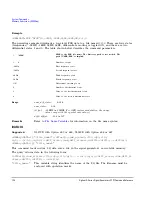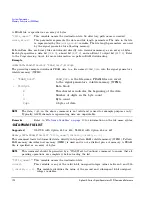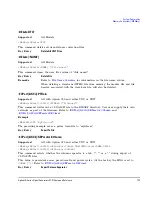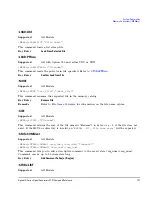
126
Agilent X-Series Signal Generators SCPI Command Reference
System Commands
Memory Subsystem (:MEMory)
:DATA:FIR
Supported
N5172B with Option 653 or 655, N5182B with Option 656 or 657
:MEMory:DATA:FIR "<file_name>",[REAL|COMPlex],osr,coefficients
:MEMory:DATA:FIR?"<file_name>"
This command loads user–defined finite impulse response (FIR) coefficient data, with a given
oversample ratio (OSR), into a file in the signal generator’s non–volatile memory. The query returns
the oversample ratio and coefficient data.
"<file_name>"
This variable is the file name of the destination file. The directory path,
/USER/FIR
is not required as it is implied by the command.
REAL
Filter with real coefficients which are applied to I and Q equally. These
coefficients are in the time domain and are supplied by the user. This type of
filter is selectable as either a modulation filter or an equalization filter.
COMPlex
Filter with complex I and Q samples (I + jQ) that are applied to the I/Q signal in
a complex manner, as in (I + jQ)*(I + jQ). These coefficients are in the time
domain and are supplied by the user. This type of filter is only selectable by the
equalization filter feature.
osr
The OSR is the number of filter taps per symbol. For an equalization filter, the
OSR must always be 1 and the filter coefficients must be sampled at 200MHz. For
a modulation filter, the OSR must be
2 and the filter rate must be sampled at 2
times the OSR.
coefficients
This variable is the set of FIR coefficients. The maximum number of taps is 1024.
For COMPlex filters, the coefficients alternate between the real and imaginary
values. There can be 2048 coefficients for COMPlex filters. The equalization filter
is limited to 256 taps.
Refer to the
Programming Guide
for more information on downloading and using files.
Example
:MEM:DATA:FIR "FIR_1",4,0,0,0,0,0,0.000001,0.000012,0.000132,
0.001101,0.006743,0.030588,0.103676,0.265790,0.523849,0.809508,1,1,
0.809508,0.523849,0.265790,0.103676,0.030588,0.006743,0.001101,0.000132,0.000012,0.00
0001,0,0,0,0,0
The preceding example downloads real FIR coefficients with an oversampling ratio of 4 to the signal
generator’s non–volatile memory in a file named FIR_1. Notice that the signal generator directory
path,
/USER/FIR
, is not needed as it is implied by the command. Refer to
File Name Variables
for
information on the file name syntax.















































